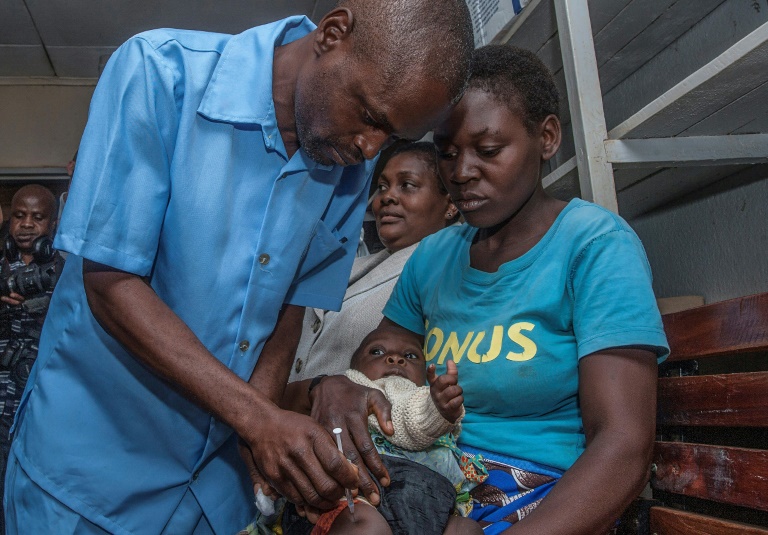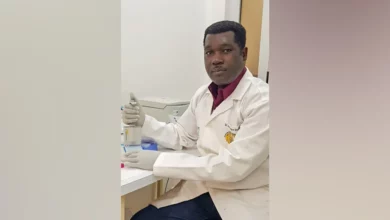
Malawi on Tuesday rolled out the world’s first licensed malaria vaccine in a landmark campaign against a disease that each year kills hundreds of thousands of people, especially African children.
After more than three decades in development and almost $1 billion (890 million euros) in investment, the new vaccine began to be distributed in Malawi’s capital Lilongwe. It will be extended to Kenya and Ghana in coming weeks.
“We have seen tremendous gains from bed nets and other measures to control malaria in the last 15 years but progress has stalled and even reversed in some areas,” World Health Organization (WHO) Director-General Tedros Adhanom Ghebreyesus said in a statement.
“We need new solutions to get the malaria response back on track, and this vaccine gives us a promising tool to get there.”
Known by its lab initials as RTS,S but branded Mosquirix, the vaccine has passed lengthy scientific trials, which found it to be safe and reduced the risk of malaria by nearly 40 percent — the best-ever recorded. It was approved by European regulators in 2015.
But Mosquirix provides only a partial protection, which means it has to be supplemented by traditional anti-malaria tools such as insecticide-treated bed nets.
In addition, four successive doses must be administered on a strict timetable for it to work — a relatively onerous schedule in rural Africa.
The three-country programme aims to immunize 360,000 children aged two years and under, partly to get a wider view on the vaccine’s effectiveness but also to see whether the delivery process is feasible.
Promising weapon
The first vaccinations were administered at Mitundu Health Centre, 45 kilometers (28 miles) west of Lilongwe.
“This new vaccination is a new tool for the control and elimination of malaria in this country,” Michael Kayange, deputy director in Malawi’s health ministry, told AFP.
Kayange said that the vaccine had the capacity to prevent one million of the six million malaria cases recorded annually in Malawi, helping to prevent 4,000 deaths.
“So, this vaccine is a huge plus to Malawi,” he said.
Mosquirix has been developed by British pharmaceutical giant GlaxoSmithKline in partnership with the PATH Malaria Vaccine Initiative.
Its scientific testing including five years of clinical trials on 15,000 people in seven countries.
Scientists say if it was rolled out on a large scale it could save hundreds of thousands of lives.
The WHO believes that the new vaccine brings a key new tool in addition to mosquito nets, insecticides and drugs in the battle against a disease which kills a child every two minutes.
Malaria is spread to people through the bites of female Anopheles mosquitoes who transfer the malarial parasite when they take a blood meal.
The WHO says malaria killed 435,000 people in 2017. The number of cases climbed to 219 million in 2017, two million more than in 2016. More than 90 percent of cases occurred in Africa.
The fight against the disease has been complicated by mosquitoes building up resistance to commonly-used drugs, according to the WHO.
“Despite gains over the last decade, we have seen a stagnation in malaria control efforts in recent years,” said researcher Jonathan Juliano from the University of North Carolina.
“In certain areas of Africa, we have actually seen rates of malaria infection get worse.
‘Milestone’
CEO of PATH Steve Davis described the vaccine’s launch as a “historic milestone”.
“A vaccine for malaria is among many innovations needed to bring an end to this disease,” said Davis.
GlaxoSmithKline Vaccines’ chief medical officer, Thomas Breuer said “delivering the world’s first malaria vaccine will help reduce the burden of one of the most pressing health challenges globally”.
Malawi, Ghana and Kenya were selected for the rollout because their malaria rates are high and they have a long history of use of bed nets and other preventative measures.
Despite concerns over the recent rise in malaria cases, the numbers dying from the disease has fallen nearly two-thirds since the turn of the century.




